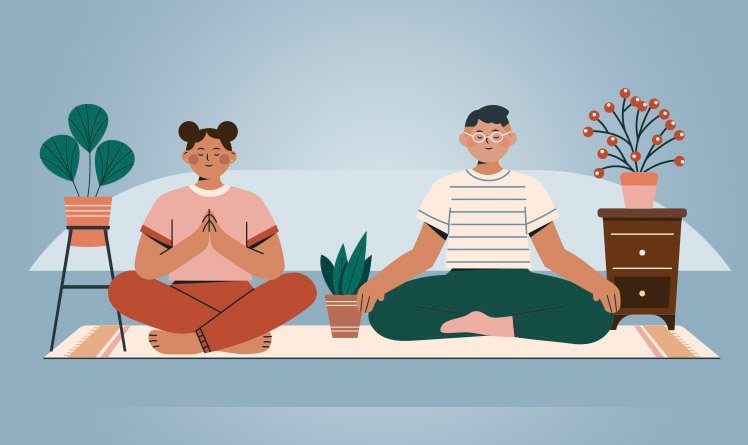Types of meditation: from zen to mindfulness to change your routine

|
Getting your Trinity Audio player ready...
|
Take a deep breath with me. Now let it out. Again. Were you able to pay attention to the air coming in and out? Or has your mind already raced to the day's to-do list? If you're like most people, you were probably already thinking about your next appointment before you even finished your first breath.
We live in a fast-paced world, where being present seems like a rare skill, almost a superpower. That's precisely why talking about meditation has never been more urgent. More than a fad or a spiritual practice, meditation has become a mental and emotional necessity for those seeking health, balance, and quality of life.
In this article, we'll talk about the types of meditation. And get to the point we want: mindfulness.
Is all meditation the same? Not at all!
You've heard it before: "Oh, I tried to meditate, but I couldn't clear my mind..." Well, that's one of the biggest myths about meditation. The truth is, there are many types of meditation, and each one works in a different way.
That way, meditation It's not just one thing. Just as there are many musical styles (from jazz to rock), there are also many ways to meditate. Some are quieter, while others involve mantras, movement, breathing, or even visualization. They all have one thing in common, however: the search for presence.
“"Meditation is the training of the mind to become aware of the present, developing focus, serenity, and self-knowledge."”
Zen Meditation (Zazen): Silence as a Master
Let's start at the root. Zazen, or Zen meditation, is a Buddhist practice that invites absolute silence—of speech, body, and mind. One sits in the lotus position (or similar), focuses on breathing, and… observes.
In other words, Zazen doesn't want you to "do something." Quite the opposite. The idea is not to do anything. Thus, the intention is simply to be there, still, attentive to your breathing and the flow of thoughts, without clinging to either.
This practice cultivates deep attention and radical acceptance of the present. Over time, the mind quiets, thoughts become less dominant, and perceptions of life shift.
Transcendental Meditation: The Vibration of Inner Sound
While Zen relies on silence, Transcendental Meditation (TM) immerses itself in sound. The technique was popularized by Maharishi Mahesh Yogi and involves the mental repetition of a personal, secret mantra, assigned by an instructor.
The mantra serves as a mental anchor, allowing you to go beyond thought, entering a state of deep rest and expanded awareness. It's as if you're slipping into yourself.
Transcendental Meditation attracts many followers in the West. After all, it's simple, structured, and offers scientifically proven benefits: stress reduction, improved attention, increased productivity, and even... improved sleep.
“"Transcendental Meditation helps to calm the nervous system, reduces cortisol (the stress hormone), and improves mental clarity."”
Guided Meditation: A Journey with a Map
You know when your mind is so busy you can't even begin? At those times, guided meditation is a true respite. Here, someone guides the process, whether with voice, music, visualizations, or instructions.
Therefore, for those who don't know where to start or have difficulty maintaining focus, this type of meditation works like an “inner GPS”.
So, to get the most out of it, choose reliable audio or video guides with pleasant voiceovers. Put on headphones, sit comfortably, and immerse yourself in the experience.
Active Meditation: the body also meditates
Who said meditation is just about standing still? Active meditation, for example, popularized by Osho, relies on movement, intense breathing, dancing, or even shouting as ways to release tension and enter a meditative state.
Thus, the idea is to use the body as a tool to escape the mind and reach presence. Because, let's face it, sometimes the mind only quiets down after the body lets go.
In addition to bringing presence, this practice also helps unlock repressed emotions and release stored traumas in the body.
“"Active meditation is a process of emotional and energetic self-liberation, where the body becomes a bridge to consciousness."”
Mindfulness: the art of being whole
And we come to the protagonist of this article. Mindfulness — or mindfulness — is more than a type of meditation. It's a way of living. It is an invitation to be 100% present in what you are doing: eating, listening, walking or washing the dishes.
But what is it? mindfulness (Really)? It's about being aware of the present moment, without judgment. Even more, it's about observing thoughts, emotions, and bodily sensations like passing clouds. In other words, it's not about controlling the mind, but about acknowledging it with kindness.
THE mindfulness is a transformative practice, because it teaches you to live here and now, it reduces anxiety, improves concentration, strengthens emotional intelligence and even helps develop self-compassion.
When you practice the mindfulness, becomes more present in every daily choice. Small gestures, like eating slowly, breathing before responding, or taking a conscious pause, change the quality of your routine and, over time, transform your life.
“"Mindfulness activates the prefrontal cortex and reduces activity in the amygdala, strengthening emotional balance and mental clarity."”
What type of meditation suits you?
This question is worth its weight in gold. After all, the best practice is the one you can maintain consistently. If you love silence, perhaps Zen. If you're looking for something more direct, perhaps guided meditation or mindfulness.
However, there's no point in choosing something that doesn't fit into your routine. Meditation isn't an obligation. It's self-care.
Furthermore, there's no "best" approach; there's only "best for you." Therefore, experimentation is essential. Try different practices, give each one time to develop, and see which one aligns best with your mind and body.
Meditation and NLP: the link between mind, presence and mental programming
Now let's bridge two powerful worlds: meditation and Neuro-Linguistic Programming (NLP). On one side, presence. On the other, mental reprogramming.
After all, when we meditate, we enter more receptive brain states (like alpha and theta). This opens up space for rewriting. limiting beliefs and sabotaging mental patterns.
One way to integrate the techniques is to use NLP affirmations, visualizations, and anchoring during or after meditation, enhancing the effects of inner transformation. Alternatively, meditate before applying NLP techniques to increase your presence in the present moment and boost the results of NLP application.
The neuroscience behind meditation
Several studies show that meditation alters the structure and function of the brain. In this sense, regular practice increases the thickness of the prefrontal cortex, responsible for decision-making, focus, and emotional regulation. Furthermore, it also reduces the activity of the amygdala, the center of automatic fear and stress reactions.
Above all, the mindfulness stimulates neuroplasticity — the brain's ability to reorganize itself by creating neural connections. This means that meditating is literally reshaping your mind for well-being.
Start simple, start today
The best way to start meditating is not to wait for the "perfect moment." After all, it doesn't exist. Meditation doesn't require special clothing, incense, or extra time. All it takes is you, a quiet corner, and a few minutes of presence.
Furthermore, the right meditation is the one you practice. In other words, you don't have to start with 30 minutes. Start with 3. Then 5. And gradually feel the effects spread throughout your routine like gentle waves that touch every part of your day.
Conclusion: changing your routine is changing your inner world
Ultimately, meditation isn't about zening out on a cushion. It's about changing the way you live. It's about learning to respond, not just react. In other words, it's about choosing to be present, even when everything pulls you away.
Every type of meditation—from Zen to mindfulness —offers a path to this transformation. It's up to you to take the first step. Your routine changes when you change the way you live your days. And it all starts… with conscious breathing.
FAQ – Questions and answers about types of meditation
1. What is the best type of meditation for beginners?
Guided meditation is ideal for beginners, as it helps to direct attention and maintain focus with the assistance of an instructor or audio recording.
2. How much time per day is enough to feel the benefits of meditation?
Just 5 to 10 minutes a day can already bring noticeable results in focus, calmness, and well-being.
3. Is it normal to get distracted during meditation?
Yes. Distraction is part of the process. The training consists of noticing the distraction and gently returning to focus.
4. Are meditation and mindfulness the same thing?
Not exactly. Mindfulness is a philosophy of full attention that can be trained through meditation, but also applied to all daily actions.
5. Is there scientific evidence to support meditation?
Yes. There are hundreds of studies that demonstrate its effects on the brain, reducing stress, improving memory and mood, and even strengthening the immune system.
Recommended reading:
Image: Adapted from Freepik
This article was originally published on March 26, 2025, and updated on this date.

Marcel Castilho is an expert in neuromarketing, neuroscience, mindfulness and positive psychology. In addition to being an advertiser, he also has a Master's degree in NLP – Neurolinguistic Programming. As the owner and founder of the communications agency VeroCom and also of the digital agency Vero Contents, he has been studying human behavior for over 30 years.



